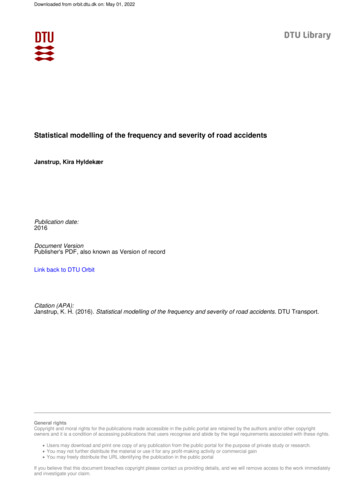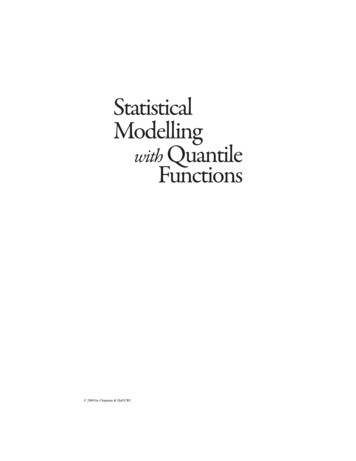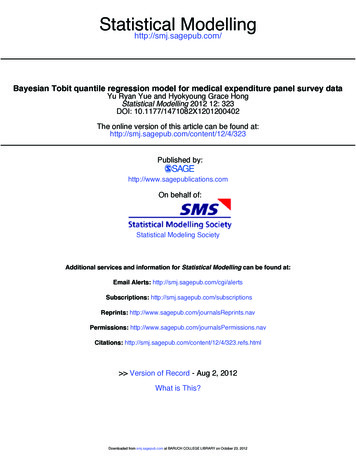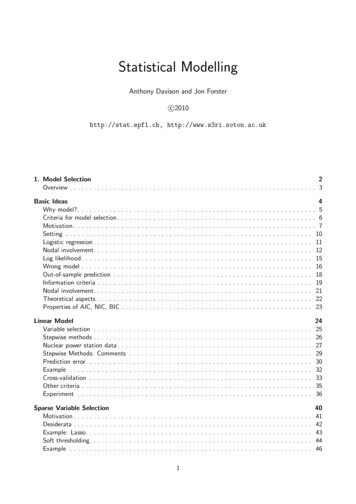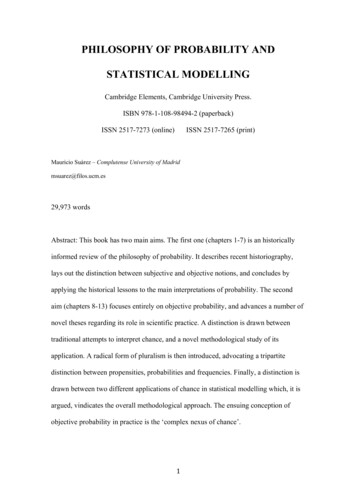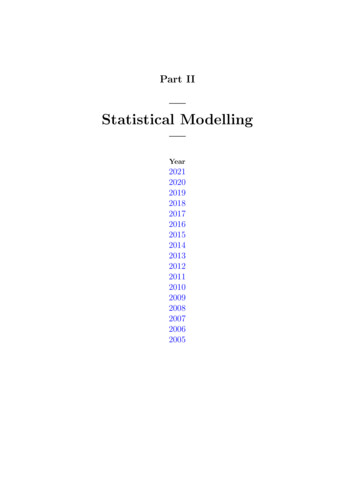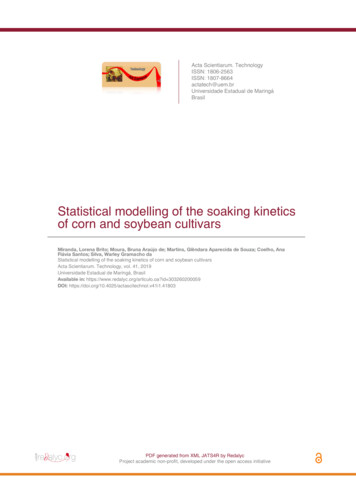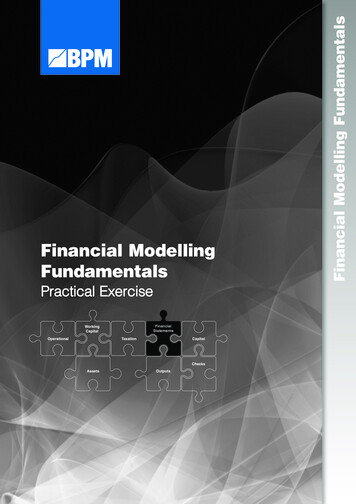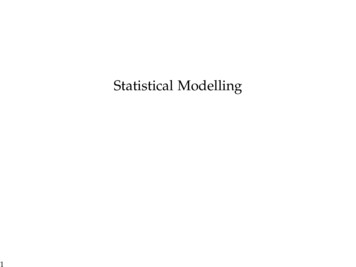
Transcription
1Statistical Modelling
2This Lecture This course covers a lot of material quickly so we aregoing to assume some background knowledge. In this lecture we will review some of the language andstatistical concepts required We will cover: what statistics is and why we need it a review of some necessary statistical language what is statistical modelling an introduction to regression
3What is Statistics? Stat[e]istics - originally conceived as the science of the state the collection and analysis of facts about a country A modern definition: statistics is a set of methods forreasoning when there is uncertainty It can be thought of as a generalisation of logic Logic is the study of methods for reasoning fromstatements which are definitely known to be true or false
3What is Statistics? Stat[e]istics - originally conceived as the science of the state the collection and analysis of facts about a country A modern definition: statistics is a set of methods forreasoning when there is uncertainty It can be thought of as a generalisation of logic Logic is the study of methods for reasoning fromstatements which are definitely known to be true or false to reason defn. to think, understand, and form judgementslogically.
4What is Statistics?An example of logical reasoning: Bananas are not spherical Apples are coloured red I take a fruit from a bowlcontaining apples, oranges andbananas The fruit is 1) spherical and 2)not coloured orange Therefore the fruit must be anapple
4What is Statistics?An example of logical reasoning: Bananas are not spherical Apples are coloured red I take a fruit from a bowlcontaining apples, oranges andbananas The fruit is 1) spherical and 2)not coloured orange Therefore the fruit must be anapple This is a logical inference No uncertainty to worry about
5What is Statistics?An example of statistical reasoning: I take a fruit from a bowlcontaining 3 bananas, 4 applesand 5 oranges. The fruit is spherical What is the probability that thefruit is an apple? 4/(4 5) 4/9
5What is Statistics?An example of statistical reasoning: I take a fruit from a bowlcontaining 3 bananas, 4 applesand 5 oranges. The fruit is spherical What is the probability that thefruit is an apple? 4/(4 5) 4/9 We have observed some data (knowledge that the fruit isspherical) and have drawn a statistical inference Statistical inferences summarise uncertainty
6Who uses statistics? Health services, corporations, governments, scientists allneed to reason with uncertainty e.g. plan health services: How many new cases of breastcancer will occur in Portugal in the next 5 years? e.g. advertising: During which TV show is it most profitableshow advertisement for a new car? e.g. science: What is the probability the observed particledecays imply the existence of the Higgs boson
7Sources of uncertainty Random sampling Want to know a fact about a population, but too expensiveto ask the question about every member e.g. What is mean age children learn to swim in Portugal? Sample 500 children in at random and use the sampleaverage as an uncertain estimate of the population average
8Sources of uncertainty Measurement error e.g. measurement resolution: continuous variables usuallymeasured on a discrete scale with a fractional resolution. We may measure a person’s weight in kg but people donot weigh whole numbers of kg.
9Sources of uncertainty Complexity - real world phenomena often random e.g. time between bus arrivals
10Statistical Language Scientists frequently study collections of objects orindividuals usually called study subjects by statisticians Typical aims:123identify qualitative or quantitative relationships betweenmeasured properties of the study subjectssummarise uncertainty about these relationshipsmake predictions about the properties for unobservedindividuals
11Study Subjects and Variables Some examplesStudy SubjectsProperties to be relatedBritish doctors cohortsmoking, death with lung cancermicegenotypes, coat colourUK Biobank cohortage, blood haemoglobin levelcancer drugsmolecular structure,mean 5-year survival rateschoolsexamination results
12Subjects and Variables A variable is a property of a study subject Variables can be observed (i.e. measured, possibly with an associated error)or unobserved, latent or random Variables can be categorical or numerical Numerical variables can be continuous ‘real numbers’(e.g. 10.71, 8.23), or discrete counts (e.g. 0, 1, 120)
13Subjects and Variables Some examplesDefinitionTypethe sex of person iCategorical (Female/Male)the weight of mouse mContinuous (e.g. measured in kg)the number brain cellsCountof person i
14Random Variables A random variable is a variable with an uncertain value e.g. Define Y by, Y 1 if the Queen of England dies with lungcancer, Y 0 otherwise The value of Y maybe 0 or it maybe 1. Until the Queendies we will not know which We can however estimate Y from measured data e.g. The Queen has never smoked but her father died ofcancer
15Data Measurements of variables generate data. A dataset is usually composed of measurements ofmultiple variables on many study subjects Convention: p denotes the number of variables in a dataset n denotes the number of study subjectsData are used to draw inferences about the relationshipsbetween variables using statistical models
16Models A model is a rule for describing a relationship betweenvariables Deterministic models are very common in physics e.g.E ( m)c2describes the relationship between E, the energy emittedwhen an atomic nucleus transmutes and m the change inthe mass of the nucleus. The relationship depends on theconstant c the speed of light This is a deterministic model. If we know m precisely wecan calculate the energy released E exactly
17Statistical Models Statistical or probabilistic models are alternatives todeterministic models which are used to describerelationships between variables when one or more of thevariables is random. Statistical models are more common in biology andmedicine than physics because biological mechanisms areoften complex and uncertain and measurements oftennoisy.
18Statistical Model: Example This statistical model describes the relationship between: 2 deterministic variables: sex and smoking status a random variable: Y 1 if individual dies with lungcancer, Y 0 if individual dies without lung cancer. The uncertainty in Y is presented as a percentage (aprobability).Smoking StatusSexY mokerFemale1%
19Regression Models A regression model describes the relationship between theaverage value of a random response variable and the valueof values of one or more predictor variables A regression is defined by1the random response variable2a list of predictor variables3a regression equation4a distribution for the value of the random response variable
20Response and Univariate Predictor
21The Response Variable The response (sometimes outcome or dependent) is random The notation Yi is usually used to indicate the responsevalue of study subject i EYi is used to denote the average or expected value of theresponse variable for study subject i Responses variables can be continuous or categorical(binary or count) The word response is used by analogy with atreatment-response experiment Such an experiment allocates subjects to treatment classesand seeks to identify differences in the distribution of theresponses between the treatments
22The Response Variable Distribution The response is usually modelled as a random variablewith a particular parametric form (shape): e.g. a Normal distribution:Yi N(µi , σ2 ) e.g. a Bernouilli distribution (i.e. a 0/1 distribution):P(Yi 1) µiP(Yi 0) 1 µi Note in both these cases we have written µi EYi
23Response Distributions Normal distribution Bernoulli distribution (0/1distribution)
24Predictors Predictors are deterministic (non-random) variables The aim of regression modelling is to associate a predictorwith a response or to associate multiple predictors withthe average value of a response variable Predictor variables are usually numerical Categorical variables can be used as predictors but thecategories must be coded numerically (more later)
25Predictor Notation The letter x is generally used to denote data frompredictor variables (although other letters are used, e.g. zis common) If a regression model has a single predictor x then xi isused to denote the value of the predictor measured onstudy subject i If a regression model has multiple predictors, doublesubscripts are used. xij denotes the data measured onstudy subject i for predictor variable j
26Regression Equation This is the deterministic bit of the regression model It describes how the average value of the response varieswith the predictor variables e.g. a univariate (one predictor) linear regression equationhas the formEYi µi α xi β
27Response and Univariate Predictor
28General Multiple Regression Equationg(EYi ) α xi1 β1 xi2 β2 . xip βp This general equation can be applied with: a range of probability distributions for the responsevariable multiple predictor variables
29Expected Value of Responseg(EYi ) α xi1 β1 xi2 β2 . xip βp EYi is the expected value of the response for subject i EYi can be thought of as the mean value of Y in aninfinitely large group of hypothetical study subjects whohave the same predictor variable measurements as studysubject i
30Linear Predictorg(EYi ) α xi1 β1 xi2 β2 . xip βp The right hand side of the equation is called the linearpredictor α is the intercept β1 , . βp are the regression coefficients The intercept and the regression coefficients are numbers α, β1 ,. βp are usually unknown The purpose of statistical analysis is to estimate α, β1 ,.βp from data
31Link Functiong(EYi ) α xi1 β1 xi2 β2 . xip βp g is called the link function g is always a monotonic, strictly increasing function This means that an increase in the linear predictorcorresponds to an increase in EYi
32Purpose of the Link Functiong(EYi ) α xi1 β1 xi2 β2 . xip βp In principle α, β1 ,. βp can each take any value between and Consequently, the linear predictor can be any valuebetween and Sometimes the distribution of Yi is such that EYi can onlytake a certain set of values e.g. If Yi is binomial taking values 0/1 then 0 EYi 1 The link function allows us to map the set of possiblevalues of g(EYi ) to the whole number line
33Interceptg(EYi ) α xi1 β1 xi2 β2 . xip βp α is the intercept term α represents the value of g(EYi ) taken by a hypotheticalstudy subject i which has predictor variables all equal tozero. i.e. g(EYi ) α, xij 0 for all j.
34Regression Coefficientsg(EYi ) α xi1 β1 xi2 β2 . xip βp The regression coefficient βj defines the relationshipbetween the jth predictor variable and the responsevariable If βj is equal to zero then a change in the value xij has noeffect on the distribution of the response If βj 0 then an increase in the value of the xij increasesthe average value of the response EYi If βj 0 than in increase in the value of xij decreases theaverage value of the response EYi
35Regression Coefficients
36Regression Coefficients
37Regression Coefficients
38Why Use Regression? There are two reasons for doing regression modelling:1Inference of relationships between variables2Prediction of response values in new subjects with givenpredictor values We address both these questions by fitting the model to data When we fit the model we can draw inferences aboutrelationships by: 1Obtaining point estimates of the regression coefficients2Quantifying our uncertainty about the regressioncoefficientsPoint estimates of the regression coefficients can then beused to predict the response in new study subjects.
39Estimating Regression Coefficients There are a number of methods for estimating regressioncoefficients from a dataset of measured values for theresponse and predictor variables. We will touch briefly on the most widely used method,maximum likelihood estimation although the details are notterribly important in practice Maximum likelihood estimation is the standard methodimplemented in most widely used statistical software Other methods include methods of moments estimation andBayesian estimation neither of which we will consider
40Likelihood Given a regression model and a dataset we can writedown the likelihood function The likelihood function is a multivariate function whichassigns a a number to each possible value of theregression coefficients L(α, β1 , β2 , .βp ) P(Yi α, β1 , β2 , .βp )i It is calculated by multiplying the probability of eachobserved response value at the desired values of theparameters
41Maximum Likelihood Estimation The maximum likelihood estimate (MLE) of the regressioncoefficients is the set of values for the regressioncoefficients for which the likelihood is largest The MLE is usually denoted using a hat symbol. β̂1 is themaximum likelihood estimate of the regression coefficientcorresponding to predictor variable 1. L(α̂, β̂1 , β̂2 , .β̂p ) maxP(Yi α, β1 , β2 , .βp )α,β1 ,β2 ,.βp iIntuitively the MLE of the regression coefficients is thevalue of the regression coefficients which makes theobserved data most probable
42Uncertainty The MLE gives us a point estimate for regressioncoefficients However, estimates are almost never correct To draw an inference about the relationship between apredictor and the response, we usually want to saysomething about our uncertainty about the correspondingregression coefficient One method of summarising uncertainty is to quote aconfidence interval
43Confidence Intervals A confidence interval is a pair of numbers L (the lowerlimit) and U (the upper limit) together with an associatedconfidence level. The confidence level is quoted as a percentage (normally95% is used) Given a confidence level of γ% a lower L(γ%) and anupper U(γ%) limit can calculated from the observed data There are many methods for calculating confidenceintervals. We will not go into the details However, most methods of calculating a confidenceinterval rely on the likelihood function
44Interpretation of Confidence Intervals The interpretation of confidence intervals can becounter-intuitive at first Uncertainty is quantified using the idea of imaginaryreplicate experiments Suppose, in an imaginary world in which time and moneyare no object, we:1repeat our experiment very many times2generate a new dataset on each occasion3calculate a new γ% level confidence interval for thecoefficient β using each datasetthen approximatelp γ% of those confidence intervalsshould contain the true value of the parameter. i.e.L(γ%) β U(γ%)in γ% of the imaginary replicates
45Interpretation of Confidence Intervals Red line is the interval calculated from the actual dataset Black lines are the imaginary intervals from repeatexperiments 95% of lines cross true parameter value
46Response Prediction with Regression Models Once we have obtained estimates of regression coefficientswe can predict the value of the response for a new studysubject i with known predictor values, using theregression equationg(EYi ) α xi1 β1 xi2 β2 . xip βp1Denote the predicted value by Ŷi . Plug in the maximumlikelihood estimates of the coefficients:g(Ŷi ) α̂ xi1 β̂1 xi2 β̂2 . xip β̂p2Invert the link function:Ŷi g 1 (α̂ xi1 β̂1 xi2 β̂2 . xip β̂p )
47Summary Statistics is a set of techniques for reasoning in thepresence of uncertainty We have recapitulated some statistical definitions (of studysubjects, variables, data etc.) Statistical models are used to describe the relationshipsbetween variables when one or more of the variables israndom Regression models are a subset of statistical models whichdescribe how the expected value (or mean) of a responsevariable depends on one or more predictor variables
Statistical Model: Example This statistical model describes the relationship between: 2 deterministic variables: sex and smoking status a random variable: Y 1 if individual dies with lung cancer, Y 0 if individual dies without lung cancer. The uncertainty in Y is presented as a percen

